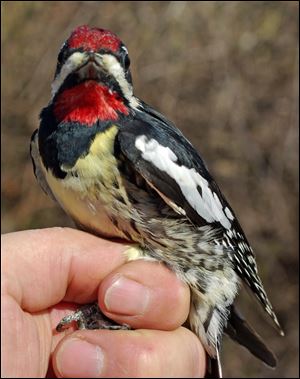
Earth Day excites birders too
Neotropicals on the move
4/17/2011
A yellow-bellied sapsucker, such as this male banded at the Black Swamp Birders Observatory, will be on the move soon.
Earth Day is coming up Friday and in a way it is a heads-up day for an ancient environmental movement that transcends millennia — the annual migrations of neotropical songbirds.
The first wave in what is characterized as a three-wave set — there also are some ripples ’twixt and ’tween — usually occurs around April 25 on the heels of some warm, southwest winds. The next wave washes into the southwest Lake Erie region around Mother’s Day, and a third occurs around Memorial Day.
It is not that many species of birds that have not been on the move northbound already. It is just that the neotropicals — usually small and often brightly colored species — are what set birding enthusiasts aglow and flocking afield with binoculars, spotting scopes, and cameras and tripods in hand.
The most popular group among the neotropicals is the family of wood warblers, with nearly three dozen species of which annually may pass through the southwest Lake Erie region. That family includes the rare Kirtland’s warbler, which nests principally in northeast lower Michigan and winters in the Bahamas. The appearance of a single Kirtland’s on the Lake Erie beachfront will set birder hotlines ringing.
Many species, from waterfowl and shorebirds to robins and other commoners, have moved in or through en masse already.
“The end of April is the time for short-distance migrants,” said Julie Shieldcastle, conservation director of the Oak Harbor-based Black Swamp Bird Observatory. “Ruby-crowned kinglets already are in, and most of the fox sparrows already have left for points north. Most of the waterfowl are gone too.”
Two of Shieldcastle’s favorite early short-distance migrants to watch for are woodpeckers: the yellow-bellied sapsucker and the red-headed woodpecker.
“Most people don’t realize that some woodpeckers are migratory,” she said, adding that a third woodpecker, the northern flicker, also migrates.
These three tree-beaters usually winter in the U.S. Southeast.
Among the prime venues to view spring migrations are Magee Marsh State Wildlife Area, the adjoining Ottawa National Wildlife Refuge complex, and the 10,000-foot boardwalk at Trautman Nature Center at Maumee Bay State Park. They are hubs of southwest lakeshore birding activity every spring.
Magee and Ottawa lie along State Rt. 2 west of Davis-Besse in western Ottawa County, and the park is at the end of North Curtice Road off Route 2 in eastern Lucas County.
BSBO is sponsoring the second annual Biggest Week in American Birding May 5-15 at these sites. For details visit on-line at www.bsbo.org.
● “If you study this book, it should enhance your ability to identify all birds, not just the ones actually discussed here. I predict that as you gain a greater understanding of what you are seeing and hearing, you will enjoy birds even more.”
Those are the words from the horse’s mouth so to speak, and they are right on the mark. They are written by internationally renowned birding authority and field-guide author Kenn Kaufman of Oak Harbor in the soon-to-be-released Kaufman Field Guide to Advanced Birding.
This wonderful field-guide-size book is more a teaching text, as hinted by the subtitle, “Understanding what you see and hear.” So don’t expect it to supplant your normal bird field guides, a host of which Kaufman also has authored.
What Advanced Birding does is take the enthusiast pleasantly onto the next plateau in this popular recreational pastime of birding, going beyond simply — sometimes hopelessly — trying to match standardized bird subjects with photographs and brief monographs.
Think of it as a teaching supplement to a standard guide.
Watch for it Tuesday, published by Houghton Mifflin Harcourt, Boston, $21.95. Kaufman is a member of BSBO, which sells all of his field guides at its nature center, 13551 West State Rt. 2, Oak Harbor, on the entrance road to Magee Marsh.
Contact Steve Pollick at spollick@theblade.com or 419-724-6068